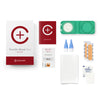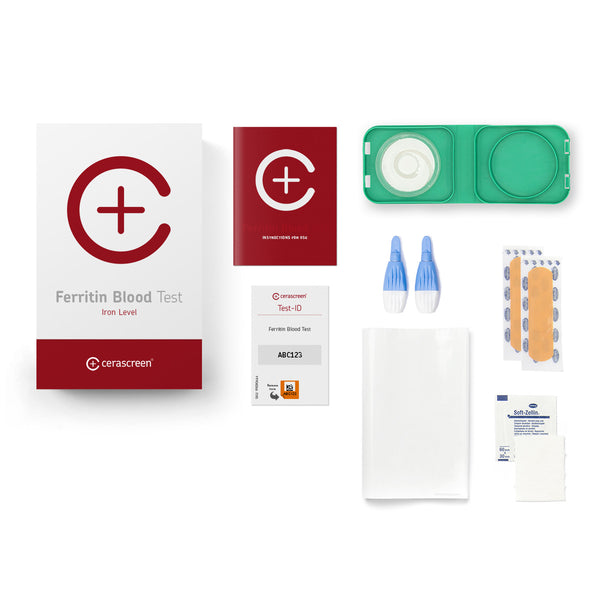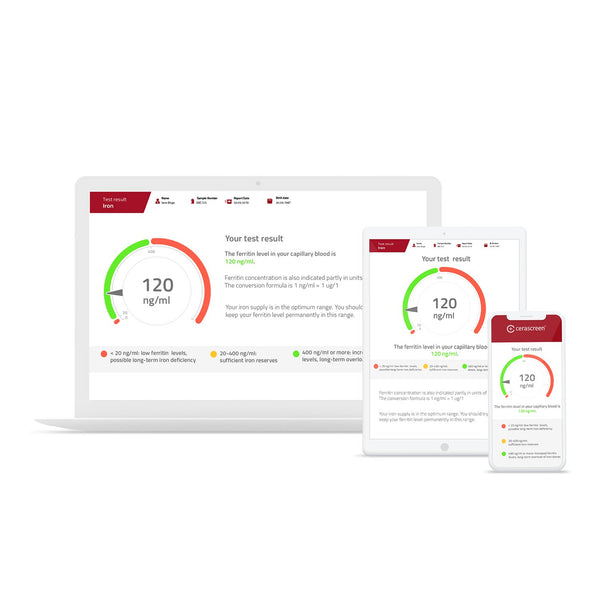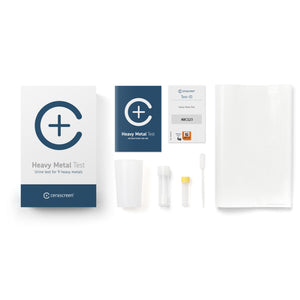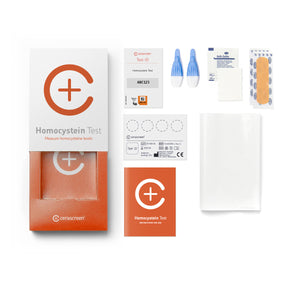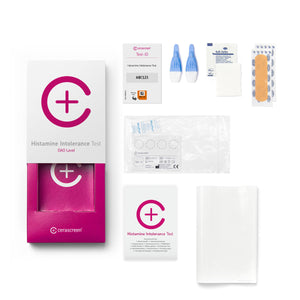product_id = 1690257195067variant_id = 15983829090363template_name =

Ferritin Test
About the test
Ferritin Test
Further complaints:
- Dry skin
- Brittle fingernails
- Weakened immune system
Receive your result within 5 to 7 working days after sample’s arrival in the laboratory
Please note: Due to the current situation, there may be significant delays in the analysis of your Ferritin Test in our medical partner laboratory. Your blood sample will be properly frozen in the laboratory during this time.
Iron deficiency symptoms
Too much or too little iron? Too much and too little iron in the body can be problematic. These are some of the scientifically proven consequences:
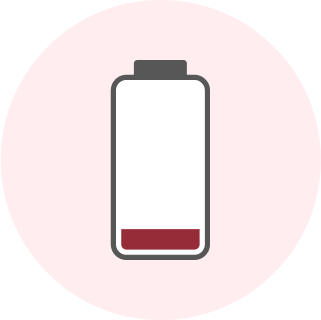
Fatigue:
In iron deficiency anemia, the blood carries too little oxygen through the body. As a result, almost all cells in the body lack energy - including the brain. This manifests itself in constant, sometimes extreme tiredness. In addition, it can lead to difficulty concentrating and reduced performance.

Hair loss:
Hair needs a lot of blood to grow properly. If the blood supply is disturbed due to iron deficiency anemia, they can become thinner and fall out. If those affected remedy the iron deficiency, this often also stops the hair loss.
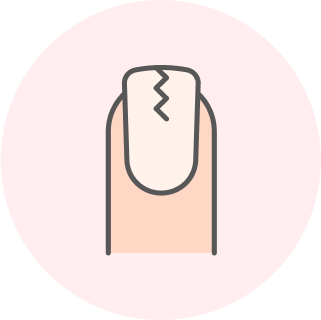
Brittle nails:
The nails also need iron so that they can grow back healthily. If there is an undersupply, they often become brittle and flake off. In some cases, grooves also form, the nails bulge upwards or are sunk downwards.

Longevity:
In some recent studies, there was evidence that people with high iron levels had a shorter life expectancy. The authors suspect that iron levels in the optimal range could slow down aging.
Source: Mangan D. Iron: an underrated factor in aging. Aging (Albany NY). 2021 Oct 6;13(19):23407-23415. doi: 10.18632/aging.203612. Epub 2021 Oct 6. PMID: 34613935; PMCID: PMC8544343.
Benefits of the Ferritin Test
Iron deficiency is the most common nutrient deficiency globally. One in three people around the globe suffers from iron deficiency. The symptoms are very diverse and often do not point towards this suspected diagnosis. Therefore, this deficiency is often diagnosed relatively late. Iron carries oxygen in the blood to all of the body’s cells, which means it is vital for the metabolism of energy in the cells. Iron levels that are too low will thus lead to poor oxygen supply amongst cells in the organs such as the brain, but also in the muscles.
Symptoms of iron deficiency
- Increased tiredness and fatigue
- Headaches and dizziness
- Poor physical and cognitive performance
- Dry skin, cracks at the corner of the mouth

Result of the Ferritin Test
As soon as your sample has been analysed, you will be able to view your individual results report in the My cerascreen® mobile app or by logging in on our website, where you can also print the report.
Laboratory analysis results: Discover how high your ferritin levels are and thus how good your body’s supply of iron is.
Frequently asked questions about Ferritin Test
Why is it useful to take an iron test at home?
Iron is an important nutrient that you need to provide your body with food. If you consume too little iron, it can have a negative effect on blood formation and the oxygen supply to the body, among other things.
If an undersupply of iron gradually sets in, we often do not notice it for a long time. The symptoms of a deficiency are relatively non-specific and not easy to identify. For example, it can happen that those affected do not notice their iron deficiency until anemia has already occurred.
To avoid this, it can be worthwhile to regularly check your own iron intake – especially if you follow a vegetarian or vegan diet, for example.
It is advisable to take such a test before resorting to iron supplements. This is because too much iron can lead to an excess of iron and also cause symptoms. With our iron deficiency test, you will receive your blood value of the storage iron ferritin from the medical laboratory - you can easily take the sample for it at home.
Who should take the test?
In principle, iron deficiency can affect people of all genders and ages. However, there are some risk groups that should pay particular attention to their iron levels.
For example, women are affected more often than men. Other risk groups include the elderly, pregnant and breastfeeding women, vegetarian or vegan people and competitive athletes. Pregnancy, breastfeeding and competitive sports lead to an increased need for iron.
How does the iron test work?
You prick your fingertip with a lancet and take a few drops Blut. In a dried blood box, send the blood sample to a specialist laboratory. A few days later, you will receive a notification and then find your individual result report online in the personal customer area my.cerascreen.
How long does the analysis take in the laboratory?
Once your sample has arrived at the laboratory, it will be analyzed there by specialists. How long the analysis takes depends on the exact measuring method and the processes in the laboratory.
If the sample is sent on the correct days (Sunday to Tuesday), this makes it easier for the laboratory to adhere to the times.
For the Ferritin Test, the laboratory analysis is usually completed within 7 working days after the sample is received in the laboratory.
Why is ferritin measured?
There are several possible levels of iron that labs can look at in the blood. However, the "actual" ice cream value in the blood (serum iron value) is only of limited significance because it fluctuates greatly depending on the time of day and meals and therefore only shows a snapshot.
In order to assess the iron supply, the ferritin value is therefore considered to be more useful. The storage value of the iron is relatively stable and hardly fluctuates. It allows a statement to be made about whether your iron stores are almost depleted or overloaded – and whether it might be worthwhile to improve the values in a targeted manner.
What does the result of the iron test tell me?
In the results report, you will get to know your ferritin level. This value is a measure of how well you are supplied with iron. You will learn which are the optimal ranges for the ferritin level and in which range your iron supply is located.
What recommendations do I get?
In the results report, you will learn how you can counteract an undersupply of iron. For example, you can change your diet and plan iron-rich foods in a targeted manner. Supplements with iron may also be an option.
What is iron?
Iron is an essential trace element – a substance that your body needs but cannot produce itself. Trace elements such as iron must therefore be consumed through food.
Iron plays an important role in cellular respiration. It is involved in producing the red blood pigment haemoglobin, which the body needs to transport oxygen from the lungs to all cells. In addition, iron strengthens the immune system and the health of skin, hair and nails.
How does my body get enough iron?
Iron only enters your body through food. Iron from animal foods is better absorbed than from plant foods. As a vegetarian or vegan, you should therefore pay special attention to eating iron-rich foods. You can also take plant-based sources of iron together with foods rich in vitamin C, which promotes absorption. For example, combinations of legumes and vegetables such as bell peppers, or oatmeal with berries rich in vitamin C are useful.
Here are some examples of iron-rich foods:
- Meat, sausage, offal of beef and pork
- Lentils, peas, beans, soy
- Amaranth, quinoa, rolled oats, millet
- Eggs
- Spinach, kale and savoy cabbage
How does an iron deficiency occur?
Iron deficiency can naturally occur if you eat too few iron-rich foods. The following applies: Women generally have a higher requirement than men, as they lose iron through the menstrual blood. During pregnancy, the need increases even further.
Other risk groups include the elderly, competitive athletes and people with chronic gastrointestinal diseases. If you belong to one of the risk groups, it may be worthwhile to test your supply of iron.
How does an iron deficiency manifest itself?
A long-term iron deficiency can lead to anemia. Your blood will not be able to supply your cells and organs with enough oxygen. Anemia is manifested by paleness, tiredness, dizziness and weakness.
In addition, other symptoms such as brittle nails, cracked corners of the mouth, hair loss and headaches are possible.
What do I do if I have an iron deficiency?
If you have been diagnosed with an iron deficiency, it makes sense to find out the causes and, for example, to determine whether there is a disease behind it that should be treated.
If the deficiency is due to an increased need or too little iron, the therapy is relatively simple. You can then change your diet and take iron supplements.
Is there an excess of iron?
It can happen that people have too much iron in their bodies. In most cases, this is due to the so-called hemochromatosis, iron storage disease. In this case, the body stores too much iron due to a genetic defect. Other rare causes include liver disease and blood transfusions.
The most noticeable symptom of an excess of iron is a bronze discoloration of the skin. In the long run, the excess can increase the risk of cardiac arrhythmias, type 2 diabetes and impotence, among other things.
Is the iron test a self-test?
Our test is a laboratory test, for which you take the sample at home. Whether this makes it a self-test depends on how you define the term. People don't always mean the same thing when they say "self-test". At cerascreen, we like to refer to our tests as self-tests because our customers can take the samples themselves at home and do not need medical professionals to do so.
Especially in the coronavirus pandemic, however, self-tests were for many above all tests that provide a result directly on site, such as rapid antigen tests for COVID-19 or pregnancy tests. Our iron deficiency test is not such a test – you take the sample yourself and send it back to us, after which a specialist medical laboratory will analyse your blood and we will send you a report on the results. This gives you a detailed, reliable result from the lab, including the exact readings.
Can I take the test if I am pregnant or breastfeeding?
If you are pregnant or breastfeeding, you can do our iron test. However, our recommendation is to discuss the results with your doctors or therapists. As with many other nutrients, pregnant and breastfeeding women have an increased iron requirement – accordingly, the reference values for them also differ from those we give in the results report. So, be sure to make sure that you can properly classify and evaluate your test results with the help of professionals. You are also welcome to use the offers directly from us and get advice from online doctors or online alternative practitioners.
The iron test is not suitable or only suitable to a limited extent for certain groups of people:
People with contagious diseases such as hepatitis and HIV are not allowed to take the iron test.
People with hemophilia should not take the blood test.
Pregnant and breastfeeding women should only perform the iron test under medical supervision. The reference values and recommendations do not apply to you either, so you should get recommendations on the test result from your doctor or therapist.
The iron test is not suitable for children under 18 years of age.
The test is not intended to diagnose serious diseases. For example, if you suffer from severe depression or extreme pain, consult a doctor.
Why are children under the age of 18 not allowed to take the test?
Our tests are not suitable for underage children and adolescents under the age of 18. People under the age of 18 cannot activate the tests online and therefore cannot receive a test result. We ask that you do not perform the tests on your children either.
Children and adolescents need much closer care and counseling regarding medical tests and their interpretation. Testing with lancets and chemicals is not without risk and would need to be closely supervised by legal guardians. In addition, the reference values we give for the measured values are always based on data from adults. In children, the risk of the results being misinterpreted would be very high.
We want to fulfil our responsibility as a provider of medical devices and ensure that children and young people are not unsettled by measurement results that are difficult for them to interpret. Since we cannot control whether the minors' legal guardians actually consent to the testing and supervise it, we exclude the tests for under-18s altogether.
This is how it works
1. Test at home
Your test kit contains everything you need to draw a small sample of blood from your fingertip. Then send the sample back to us free of charge in the enclosed return envelope.
2. View results online
After the evaluation in the medical specialist laboratory, you will have online access to your personal result report.
3. Act
Your access to the test results and the evidence-based findings and tips to improve your health: the my cerascreen® user profile on our website or our app.



